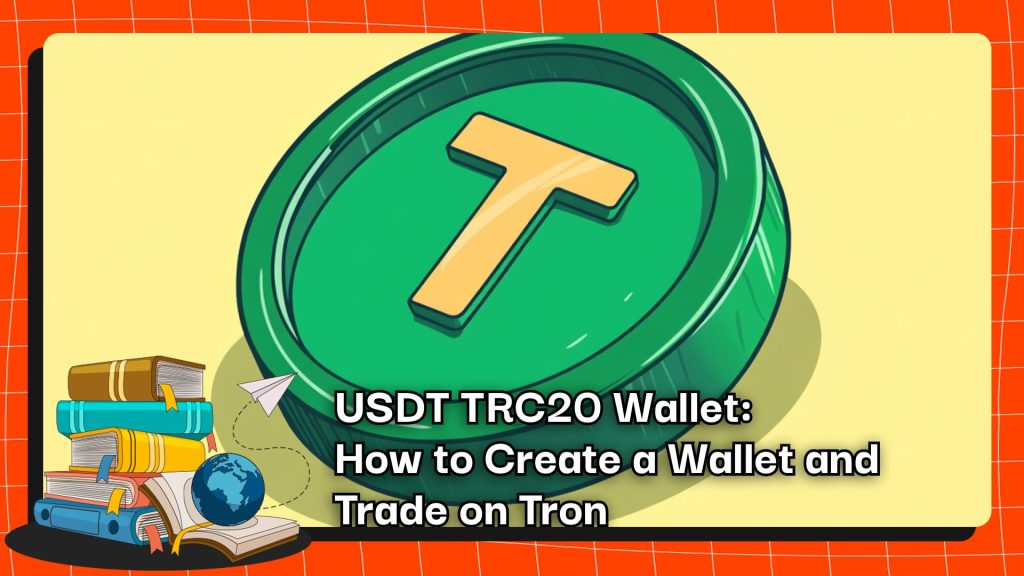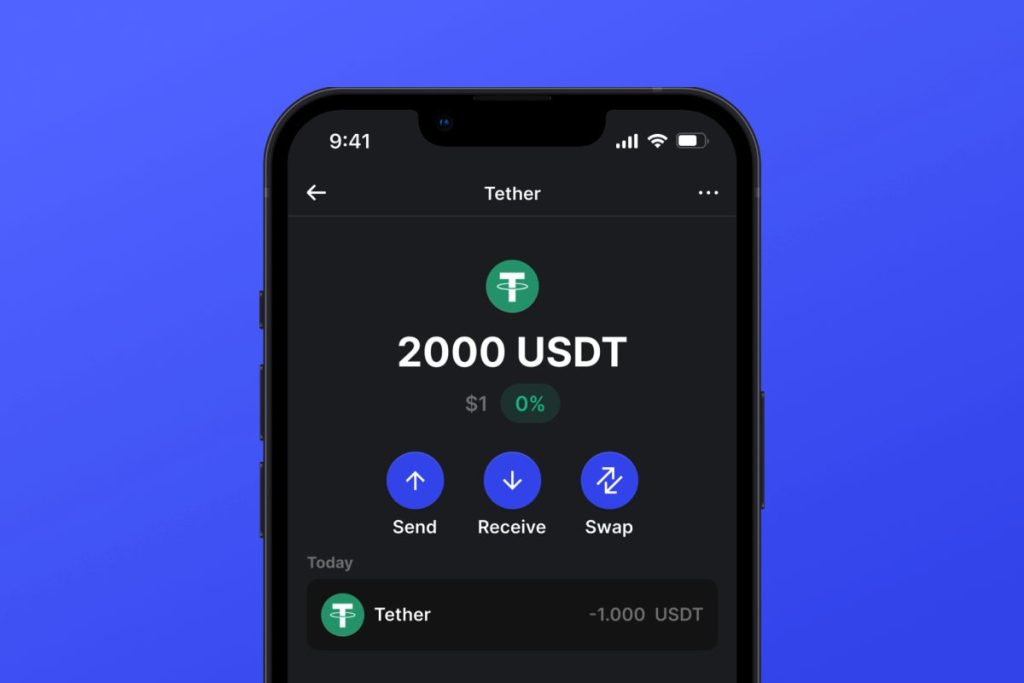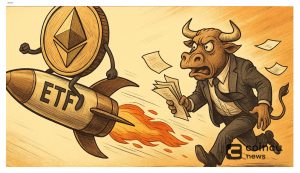USDT is the most popular stablecoin in the crypto market. Due to the recent trend of TRON and its TRC20 standard, making a USDT TRC20 wallet has become a priority that will enable users to save on costs and make faster transactions. This Coincu‘s article will guide you on how to create a USDT TRC20 Wallet.

What is USDT TRC20?
USDT TRC20 is a variant of Tether over the Tron blockchain that is recently gaining momentum. This cryptocurrency enables users to send or receive money at a higher speed and at a lower fee compared to any other blockchain network.
USDT TRC20 is supported on the open-source blockchain TRON network, which is renowned for its rapid growth. TRON initially issued as a token on the Ethereum blockchain, moved to its chain later, further enhancing the capabilities. The infrastructure of the TRON provides full support for smart contracts and thus is perfectly suitable for dApp development.

Read more: What is the TRC20 Standard? Learn About Transactions Supported by TRC20
What is the TRON Network?
Tron is a blockchain platform that aims to provide a decentralized virtual machine to developers for creating and deploying dApp. Support for the platform comes from the Tron Decentralized Autonomous Organization, a non-profit foundation. TRX is the native cryptocurrency of the Tron blockchain.
Difference Between TRC20 and ERC20 Versions of USDT
While USDT TRC20 and ERC20 represent the same underlying token, the operations are fundamentally different because of the features set by each respective Tron and Ethereum ecosystem.
Network Differences and Contract Addresses
USDT TRC20 works on the Tron blockchain, while USDT ERC20 goes on the Ethereum network. That is the simplest way of differentiating them; it comes from their addresses: TRC20 addresses on Tron will start with a “T,” while ERC20 addresses on Ethereum will start with “0x.” And since these are tokens created on the respective blockchains, this applies to all tokens created on said blockchains.
Transaction Speed and Costs
Among the key advantages of TRC20 USDT is the usage of the Tron network’s efficient consensus mechanism, which facilitates high throughput in transactions and faster times of processing. This efficiency translates into low transaction fees relative to those on the Ethereum network. In contrast, ERC20 USDT operations on the Ethereum network have the tendency to be very slow and costly, especially during periods of congestion.
Integration with Ecosystem
Due to the deep integration of USDT ERC20 in the entire Ethereum ecosystem, that means compatibility across a wide range of decentralized applications, exchanges, and services. In this way, it is flexible for users. TRC20 USDT, however, has its specific application in the Tron ecosystem, where it does attract very strong support; it may have complications in use compatibility in cases where it interacts with platforms outside the Tron network.
Security and Reliability
Both of them utilize the powers each network has. Ethereum’s established framework gives ERC20 USDT a secure and sound base, while Tron does for TRC20 USDT in scalability and efficient transaction execution, hence being more acceptable for any person who cares about speed and cost efficiency in his or her transaction.

Read more: An Overview Of TRON Exchange How To Trade TRX Effectively
Benefits of Using a TRC20 Wallet for USDT
With the TRC20 tokens, there was an introduction of several improvements to be incorporated, such as the increase in speed and security in the ecosystem. These advantages of transactions mean that one has to pay fewer fees for the transaction and is able to trust the network. Therefore, TRC20 tokens are the most favoured crypto choice. Their compatibility with other cryptocurrencies and applications results in great popularity among users.
Effective private key management and the usage of secure wallet addresses ensure the safety of the user’s assets in the process of trading USDT TRC20. With such features, TRC20 tokens would become a sweet sail for users who aim to have an easy, smooth experience in reliably and effectively interacting with stablecoins.
Here is where the USDT TRC20 wallet would be a pragmatic entry point toward the greater world of cryptocurrencies, underlining how this token could become one of the most optimized and promising options.
Read more: What is Ethereum? The Cryptocurrency Creates Blockchain Breakthrough
Step-by-Step Guide to Creating a USDT TRC20 Wallet
Step 1: Choosing the Right Wallet Provider
Since there are so many crypto wallets, the right choice has to be the most desirable. Therefore, among the popular options for keeping USDT TRC20 are TronLink, Ledger Live, and Trust Wallet. The choice depends on several factors such as security features of the wallet, ease of use, and reviews from users. Proper research will enable you to choose a wallet provider that will best fit your trading and security needs.
Step 2: Downloading and Installing the Wallet
Once an appropriate USDT TRC20 wallet has been identified, one must download and install the wallet application on his device. Typically, this is done by accessing the host wallet’s official website or through an authorized app store to ensure that the version downloaded is not corrupted.
Step 3: Creating a New Wallet
Once installed, open the wallet application and follow the on-screen instructions to create a new wallet. This typically includes generating a strong and unique password along with a recovery phrase. Recovery phrases are important to be stored securely offline since it will be needed in any case when one loses a device or has it stolen.
Step 4: Configuring Your Wallet for TRC20
Selecting the TRC20 Network
With your wallet set up, the next step is to configure it for USDT TRC20 transactions. Start by connecting your wallet to the TRON blockchain network. If your wallet has native TRON support, this can typically be done through the wallet’s settings.
If your wallet lacks native TRON support, consult the provider’s instructions for alternative methods to connect, which may involve using adapters or react hooks to integrate the TRC20 functionality.
Adding USDT TRC20 to Your Wallet
After connecting your wallet to the TRON blockchain, you are prepared to add USDT TRC20 tokens. Tap “Add Token” or “Add Custom Token,” as seen on most wallet interfaces.
Write the exact address of the TRC20 token, which can be found on the official Tether website or any other trusted blockchain explorer. Be very certain to select USDT with a TRC20 standard for compatibility, as USDT tokens exist on a variety of blockchain networks.
Read more: Top 5 Projects On TRON Blockchain
Top Wallets That Support USDT TRC20
When working with the USDT TRC20 token, the first thing to do is find a wallet that shows compatibility but with a strong level of security. A few popular choices include:
- Cryptomus: This is considered one of the top choices for managing USDT TRC20 tokens due to their strength in security and ease of use. Cryptomus offers strong security measures, including 2FA, staking options, and auto-conversion, making it highly versatile for managing your digital assets.
- TronLink: Perfect for those whose number one priority is fluent integration with the TRON network, TronLink provides seamless user experiences and a simple way to manage TRC20 tokens. This is a good choice in case you’re focused on using the features of TRON efficiently.
- Atomic Wallet: Relatively easy with crypto swapping, Atomic Wallet also supports USDT TRC20. Comparatively user-friendly, it is one of the most easy-to-use wallets for those users who deal with a lot of digital assets.
- MathWallet: Designed for users in search of an integrated DeFi experience, it greatly supports many DeFi applications and an enormous number of cryptocurrencies, including USDT TRC20. In general, it is a full-featured solution for those heavily engaged with DeFi systems.
- Klever: When mobile access is crucial, Klever is a decent option. It is comfortable to work with as a mobile wallet, and thus it will be quite enough for those who need to manage their assets on the go.
What Is USDT TRC20 Wallet Address?
The USDT TRC20 address is most important to anyone wanting to engage with the TRC20 tokens on the TRON blockchain. It is basically made up of alphanumeric strings starting with “T”, consisting of a mixture of uppercase and lowercase letters and numbers. A typical USDT TRC20 wallet address would look something like this: TEyrLpJDQ6x7J8XuPw959Rb2PCoUDp8xMM.
Upon creating a USDT TRC20 wallet, one is provided with a wallet address through which the user is allowed to receive and manage USDT tokens securely. You are highly warned to verify the correctness of the wallet address when sending or receiving any funds to avoid issues like lost transactions or delays.
Besides wallet addresses, of importance would be an understanding of the USDT TRC20 contract address. The address of a contract is a sort of identification of the smart contract a given USDT token has built on the TRON blockchain.
Conclusion
Selection of a USDT TRC20 wallet is closely connected with a few advantages that refer to the TRON network. Its blockchain offers speed regarding the execution of transactions, lower fees in comparison with other blockchains, and above all, it ensures strong security. All these put together make the TRC20 wallet appealing for users as it can effectively provide efficiency, affordability, and security over their digital transactions.
FAQs
Is TRX the same as TRC20?
No. USDT is a type of cryptocurrency, and TRC20 is a token standard used on the TRON blockchain.
Is TRON on the Ethereum network?
Yes. TRON is on Ethereum with smart contract is 0x50327c6c5a14dcade707abad2e27eb517df87ab5.
Can I transfer USDT from an ERC20 wallet to a TRC20 wallet?
Yes. USDT ERC20 can be converted to USDT TRC20 via cross-chain bridge platforms and transferred to TRC20 wallets.
How do I get a USDT TRC20 wallet address?
You can view your token address in a wallet that integrates the TRC20 network by clicking “Get Address” or clicking on your token.
| DISCLAIMER: The information on this website is provided as general market commentary and does not constitute investment advice. We encourage you to do your own research before investing. |






















